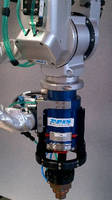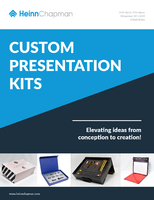Six-Axis Laser Welding Robot features integrated beam guidance.
Share:
Press Release Summary:

Featuring 20 kW capacity, Model RV60-26-FT includes hand axis in which laser beam can be set and aligned with additional adjusting features. All optical components in hand axis are continuously water-cooled. With integrated beam guidance, fiber optic cables are located in arm structure so that fiber supply does not form interfering edge that restricts robot's work envelope. Motor-driven focus adjustment enables energy density and beam diameter of component to be changed, optimizing processing result.
Original Press Release:
New Reis Laser Robot RV60-26-FT with Integrated Beam Guidance for Highest Laser Capacity
Laser welding in a new dimension
Reis Robotics started integration of laser beam guidance systems into the robot arm in the 1990s as this design offers a lot of advantages. The new six-axis laser robot type RV60-26-FT (Fiber Transfer) with a redesigned hand axis now clears the way for highest laser capacity (presently up to 20 kW), longer reach, higher handling weights for different welding optics and more powerful beam guidance and optic systems. Specifically in the range of rail vehicles, crane and shipbuilding, building machinery, and production of large components or components with great wall thickness in the general industry there is an increasing demand for applications with higher laser capacity. This trend is particularly magnified by the increased demands of the quality of components, decreased investment and operating expenses for laser sources, a more precise prefabrication of the components and the availability of new systems and system technology for laser material processing.
"The laser has left its niche existence long ago and is becoming more and more popular, not only in the automotive industry, but also in the general producing industry. Because advantages such as targeted energy input and thus less distortion, and high processing speeds, as well as reduced rework are the clear advantages of laser systems," states Markus Krütten, sales manager of the laser system technology division at Reis Robotics. "More and more customers today recognize the advantages of laser hybrid welding. The combination of laser and MSG arc welding process allows even higher welding speeds related to increased penetration depth, a bigger gap bridging ability and less distortion. The advantages of laser processing have convinced a great number of customers already, and more than 200 Reis robots are being used in laser material processing in the most diverse application fields.”
To apply the high capacity of fiber, disk, and diode lasers available today to the work piece with low loss, the designers of Reis Robotics and Reis Lasertec decided to further develop the already field-proven performance of integrated beam guidance to comply with the increased energy level. In addition, a lot of practical experience was incorporated in the joint project. The result is a very robust new hand axis on the RV60-26-FT in which the laser beam can be set and aligned with additional adjusting features. All optical components in the new hand axis are continuously water-cooled and therefore fit for high capacities and long duty cycles. With the integrated beam guidance, Reis Robotics lays the optimally protected fiber optic cables into the arm structure of the robot. An important advantage of this is that the fiber supply does not form any interfering edge that would restrict the robot's work envelope. Additionally, due to the 6th axis of the robot, it is possible to turn filler wire, sensors, and process gases around the laser point. This results in better accessibility to the component and processing of complex contours which are often not feasible with conventional robot solutions. Great dynamics, the high repeatability, and an increased handling weight for the adaptation of a wide range of processing optics make it perfect.
Laser beam guidance integrated in the robot arm therefore not only has significant advantages over conventional systems with external beam guidance, but also over stationary laser systems where the component to be processed is moved. The robot, with its compact wrist module, is freely moving to a large extent and can even process complex components shaped in 3-D with undercuttings. Reis now complements the comfortable processing renowned for many years with the new reisPAD. As intuitive human-machine-interface, it reduces the programming times further and increases the ease of operation by a whole string of innovations.
New optics from Reis Lasertec integrated optimally
For optimum use of the advantages of the integrated beam guiding, Reis Lasertec developed a new Modular Welding Optics (MWO) system especially for the new robot in the development project. It includes all supply lines for cooling water, inert gas, compressed air (for operation of a cross jet) and the monitoring of the focusing lens. Cameras and process monitoring sensors can be adapted for coaxial monitoring or programming as well as an external wire feed unit. In addition to the low weight, this compact unit also provides the advantage that, even with all the above-mentioned additional modules, no additional interfering edges will be generated which limit the work envelope, can get caught on fixtures or are subject to increased wear due to the movements.
Motor-driven focus adjustment as further robot axis
The new Reis laser robot offers another highlight in operation: A motor-driven focus adjustment or, in other words, a continuously shifting lens in the beam way. With this adjustment, it is now possible to change the energy density and the beam diameter on the component, and thus enhance the processing result. Since the tool length does not need to be adapted for this process, another advantage arises: add-on components, like filler wire and inert gas nozzles, need no longer be readjusted manually.
Due to integration of the additional fast axis into the robot control ROBOTstar, the user enjoys ease of operation and flexibility for processing of components with different joint geometries and wall thicknesses. The user quickly realizes the time savings and flexibility for welding due to the many convenient components.
The laser robot arm - integral part in the new laser gantry
If processing of very large components with a laser welding system is required, a classical 6-axis articulated-arm robot reaches its limits regarding the work envelope and the possible accessibility. Furthermore, without a robot, there remains more space on the floor in the work envelope for components and fixtures and moving positioning systems. Articulated arm robots can reach their limits in terms of accuracy in certain applications as well. In order to get past these restrictions, Reis is developing a new innovative laser gantry RLP60-26FT. It profits from the new "upper arm" with integrated beam guiding through the robot structure and the hand axes 4 - 6. The gantry, however, makes a huge processing area of up to 30 m in length possible. "In addition to the large work envelope, gantries distinguish by high dynamics, increased accuracy, extended accessibility and their special flexibility," Markus Krütten adds. "Underneath the gantry, the complete work envelope is freely accessible and is available for fixtures and positioning systems because the robot only operates from the top. Many components can be processed from five sides in one clamping without additional turning or tilting."
Result
Customers' requests are as varied as their products. The challenge therefore is to elaborate an individual, optimum adjusted solution in close cooperation with the customer. The new laser robot RV60-26-FT and its modified use in the laser gantry RLP60-26-FT now provide for even more specific adaptation to the customer's requests and/or the respective requirements of a project. Due to the extended product range, the previous laser robot RV16L-FT and the established laser gantry RLP16-FT is available, as well as the new model RV60-26-FT. The new large gantry RLP60-26-FT will be available in addition in the first half of the year 2013. In combination with the large variety of processing optics and safety systems from Reis Lasertec, Reis Robotics repeatedly finds custom-fit solutions for the most varied customer requirements.
Reis Robotics
Reis Robotics is an innovative company leading in robot technology and system integration. The Reis Robotics group with international activities has its headquarters in Obernburg/Germany and is a market leader for automation systems in the photovoltaic industry. For more than two decades Reis has been one of the most important integrators for automation systems in all major industry sectors. In addition to articulated arm robots the product range also includes linear robots, gantries, horizontal articulated arm robots and other special robots. Additional products include Try-out and Spotting Presses, as well as Trim Presses and Trim Tools.
Reis Robotics designs, delivers and installs completely integrated automation systems from one source. The company’s success since 1957 is based on the great experience gained during planning and execution of turnkey automation systems. For this, Reis Robotics offers a broad product range of industrial robots (welding robots, casting robots, handling robots, laser robots, soldering robots, assembly robots, and many others), peripheral modules and services for automation solutions in all major application fields.




